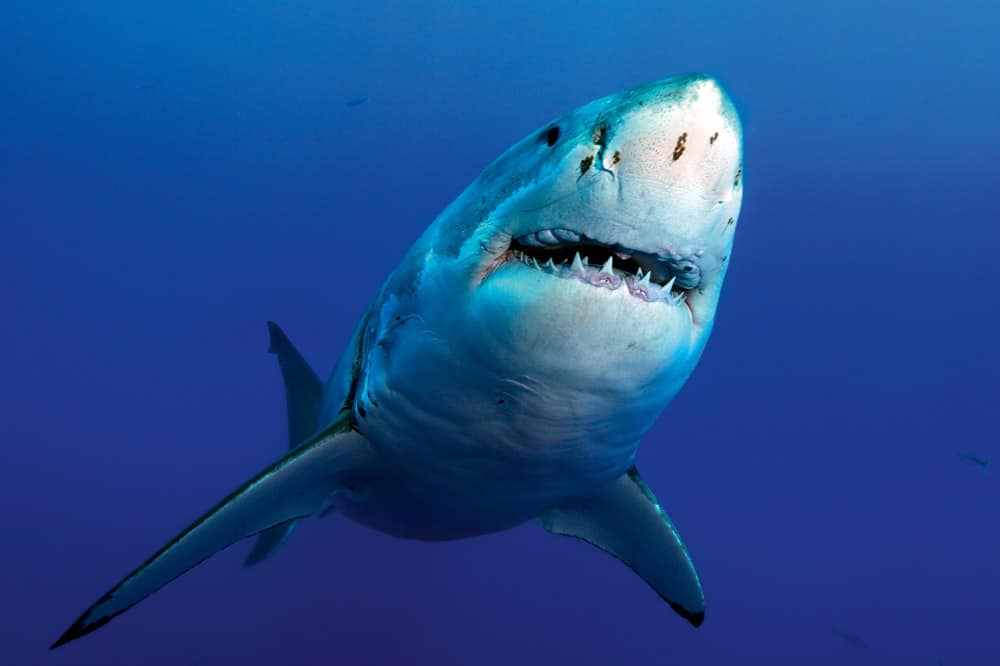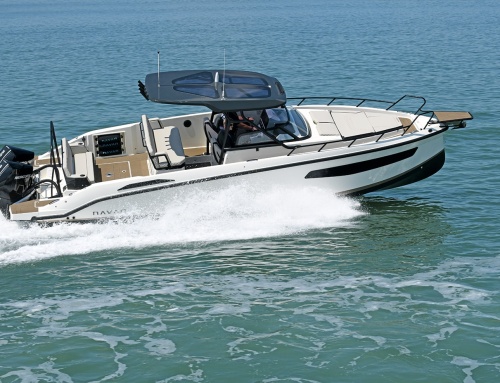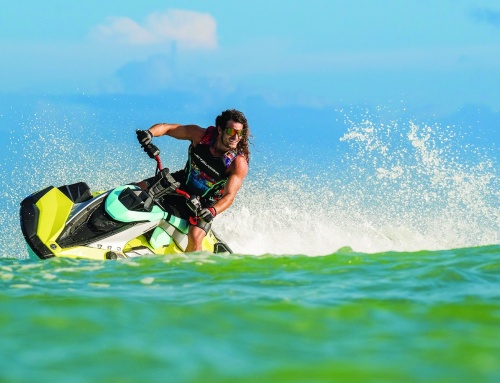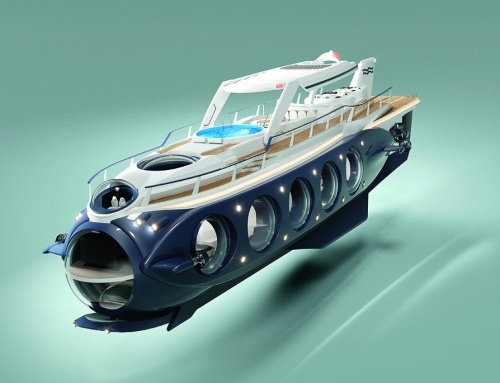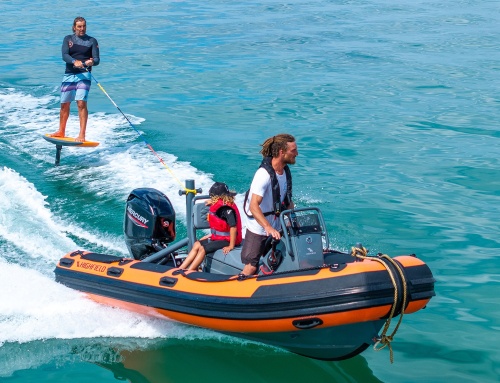PBR’s marine biologist, Giovanna Fasanelli, provides a fascinating insight into the global comings and goings of great white sharks, revealing where their existence is being threatened and why our oceans so need this prehistoric predator.
Meeting of majesty
Cape Town, my home, was once touted as the ‘great white shark capital of the world’. My first outing to observe these compelling predators, back in the winter of 2008, was an unforgettable day. We motored out from Simonstown Harbour pre-dawn to the waters surrounding Seal Island, guided by passionate conservationists and the founders of Apex Shark Expeditions, Chris and Monique Fallows. Chris brought the unique ‘flying sharks’ of False Bay to the world’s attention after first observing their aerial antics from a kayak in 1996. He has subsequently captured some of the world’s most publicised images of breaching white sharks, while becoming a formidable and unstoppable advocate for the species’ preservation. We were in superior hands!

Great white shark with its main four fins swimming in the Pacific Ocean at Guadalupe Island in Mexico
‘Seals! 12 o’clock! Don’t look away!’ Monique exclaimed. Then, as if an underwater bomb had gone off, the silky sea exploded, lifting out what appeared to be a 4-metre marble sculpture of a deep-sea leviathan, its mercury-coloured body glistening in the golden dawn light, its jaws empty and wildly clenched as it narrowly missed the tail flipper of a young seal. By lunchtime we had witnessed over a dozen of these epic breaches, some completely clear of the water, as different sharks attempted to capture frightened fur seals swimming at the surface. These precious few hours remain arguably the most riveting wildlife watching of my life. My memories, however, now carry a solemn sting as I consider the world merely 15 years later: these beasts are all but gone from the waters of False Bay for reasons that are hotly contested. Despite their fame, these predatory giants remain largely an enigma, and yet, lamentably, their fate appears to lie in our hands.
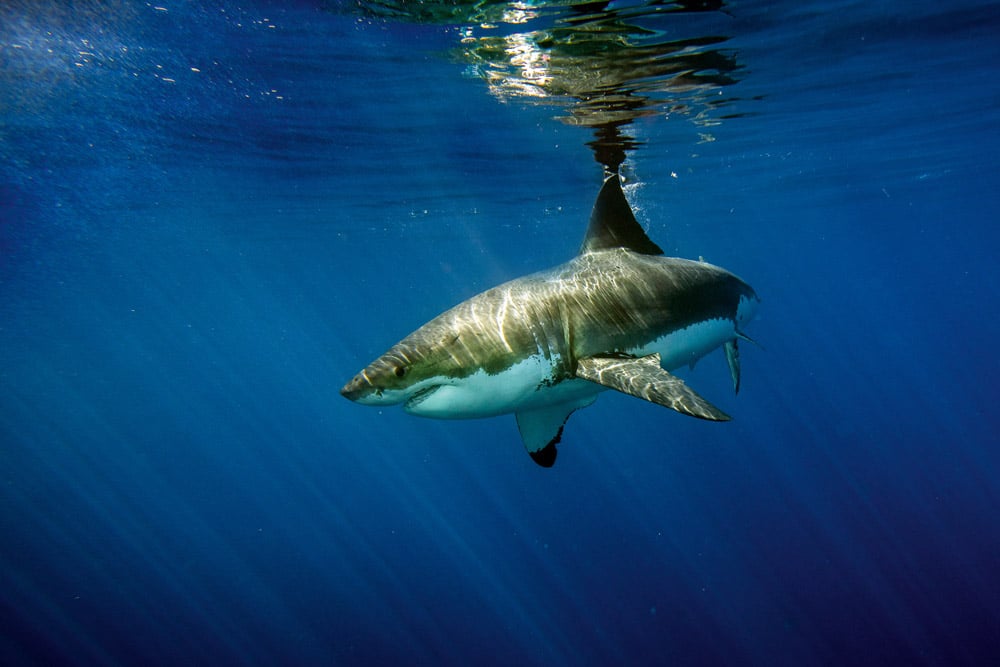
Gatherings of the great ocean nomads
The white shark (Carcharodon carcharias) is a temperate cosmopolitan species tolerating waters between 5 and 24 degrees centigrade, roaming far, wide and deep (even down to lightless realms at 1200 metres), and capable of extraordinary migrations, sometimes across entire ocean basins. Shark scientists have, however, isolated six genetically distinct population ‘hot spots’ around the globe: the North-West Atlantic, the North-East Pacific, the Mediterranean, Australia/New Zealand, South Africa and the North-West Pacific.
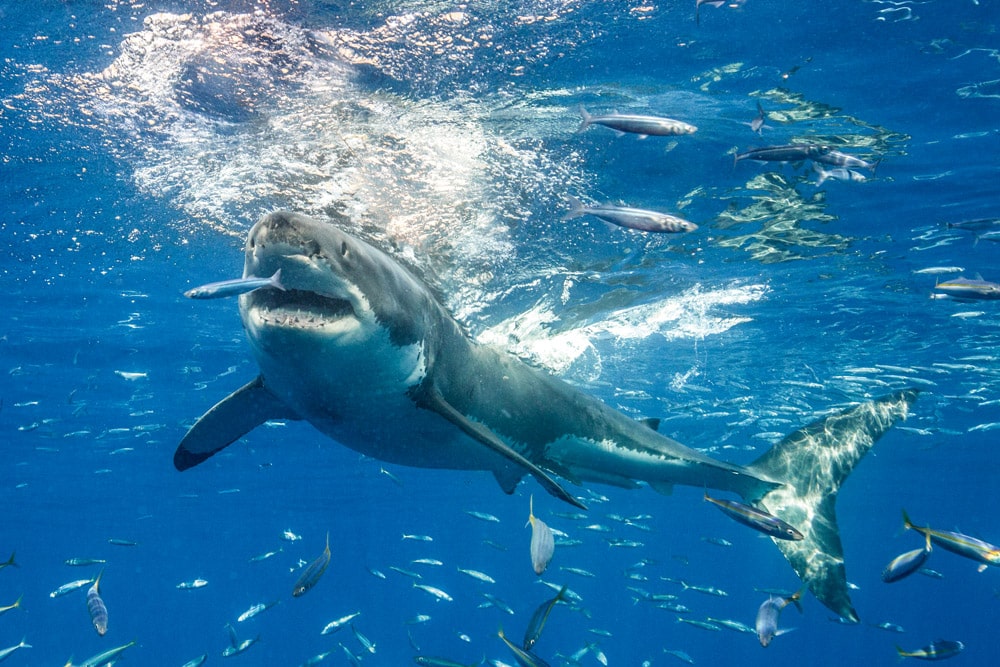
Cage Diving with great white sharks off the island of Guadalupe in Mexican waters of the Pacific Ocean
But ask the experts how many white sharks are alive today and the answers are vexatiously vague and wide-ranging. However, more important than knowing how many we have left is what trends are showing up in the relative-abundance data. Are our recovery methods proving effective or not? Through satellite and acoustic tagging projects and the collection of genetic material, biologists have managed to shine some light onto the species’ black hole of data deficiency. Of particular conservation interest has been establishing the location of mating, pupping and nursery grounds, areas that are utterly crucial for the recovery and persistence of local populations (and hence the species as a whole). The young sharks, which are born at lengths of around 1.4 metres, need prey-rich, protected areas to safeguard them from larger predators. Biologists have been working hard to identify these critical areas:
- North-East Pacific: Point Conception to San Diego (California) and along the Baja Californian coast, including Sebastián Vizcaíno Bay (Mexico).
- North-West Atlantic: Near Montauk, Long Island (New York/New Jersey Bight).
- Australia (two subpopulations have been identified): Eastern – Port Stephens (New South Wales) and Ninety-Mile Beach (Eastern Victoria); Western – suspected around Recherche Archipelago (Western Australia); New Zealand: suspected nursery areas around the top half of North Island.
- South Africa: Algoa Bay (Eastern Cape).
- Mediterranean: Sicilian Channel and the Aegean Sea.
- North-West Pacific (Japan and surrounds): Data deficient.
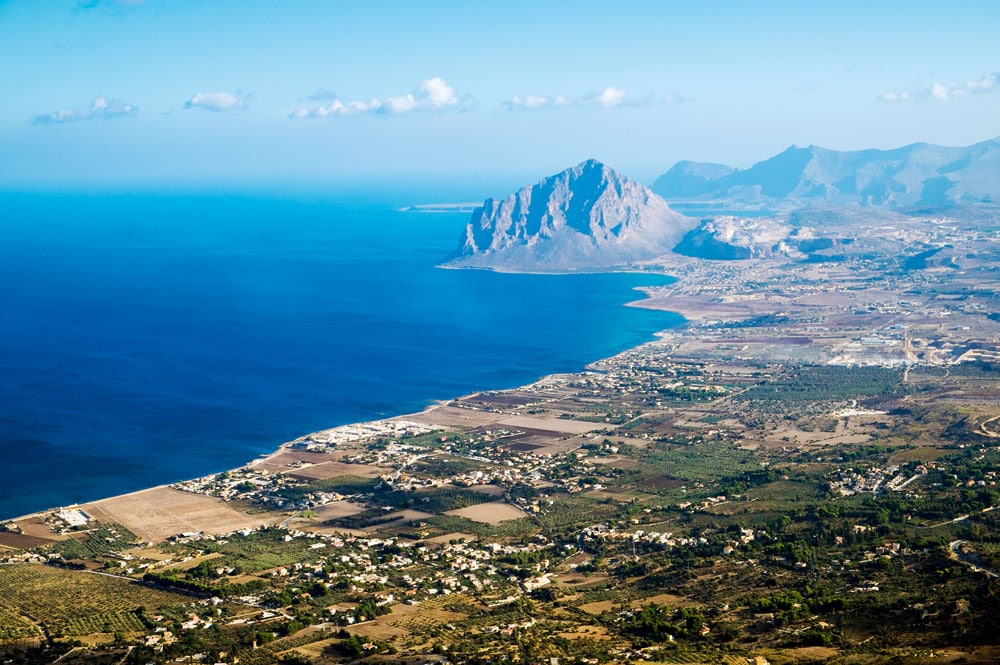
Aerial view of Sicily west coast from Erice, Italy
As battery technology improves, satellite pop-up tags can now deliver data points over multiple years, which has allowed researchers to understand a great deal more about the reproductive biology and motivations of adult sharks over the course of their lives. Thanks to a 2013 study by Michael Domeier, President of the Marine Conservation Science Institute, we now have a clearer picture of the two-year breeding cycle patterns of adult females as they move from their mating grounds off Guadalupe Island to pupping grounds off Baja California, Mexico, and back to Guadalupe to mate again. This information highlights the anthropogenic risks that pregnant sharks are exposed to as they approach their coastal pupping sites – risks that then extend to their offspring, which will spend the first few years of their lives in these inshore areas. Encounters with shipping traffic, overfished and polluted waters and, most worryingly, subsistence and commercial fishing activities are significant threats, especially to the young sharks. Careful stakeholder management of these sensitive breeding areas is crucial to the species’ survival.
Goodbye to Cape Town

12 Apostles Cape Town SA © HMS
So where are the majestic sharks that put False Bay on the world map? The rapid decline in sightings in the bay began in 2017 when the annual average dropped from 205 to 50. It then fell to zero in 2019. It took 20 months before a single white shark was seen in the bay again. A very popular theory in play is that a sudden increase in attacks by new resident orca (two in particular named Port and Starboard, as their respective dorsal fins droop left and right) has frightened the sharks into moving further to the east to areas off Mossel Bay, where sightings are still reliable. But Chris Fallows of Apex Shark Expeditions points us to the illegal and rampant fishing of small shark species such as school and gummy sharks, which supply 60% of the white’s local diet. The meat of these small sharks is sold to Australia as ‘flake’ for the fish and chip market.
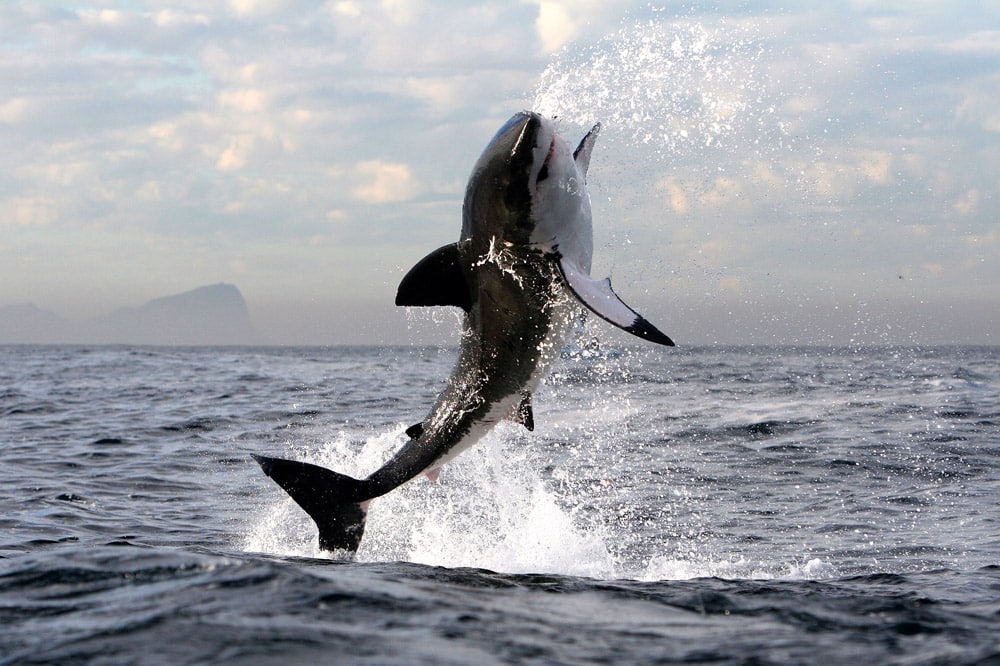
Breaching Great White False Bay South Africa May 2008
Another concerning factor not to be ignored is that the local population estimate for South African breeding sharks is now believed to be approximately 300 individuals, 200 shy of what is estimated as being sufficient to keep the population genetically viable. Death by beach safety nets and commercial fishing continues to chip away at the population every year, which points to a very uncertain future for South Africa’s white sharks. Will these majestic hunters return to False Bay? Tour operators, who have had to radically adapt their businesses to stay alive in the wake of this shock wave, can only hope so, but no one is holding their breath any longer.
Hello to Cape Cod: a shining example
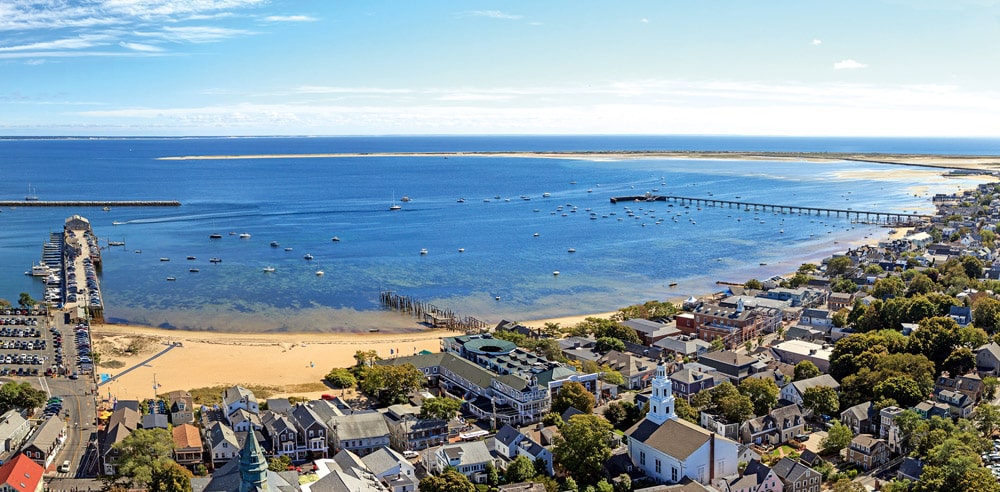
Provincetown, Massachusetts, Cape Cod city view and beach and ocean view from above.
While False Bay’s shark tourism takes a nosedive, enthusiasts are, ironically, flocking to the scene of the Jaws movie set, Cape Cod. Dr Greg Skomal, a senior biologist with the Division of Marine Fisheries in the USA and the state of Massachusetts’ pre-eminent shark expert, has been studying the resurgence of white sharks on the Massachusetts coastline at Cape Cod over the previous decade. ‘It’s a combination of factors. With prohibition on retention implemented in 1997, the white shark population in the western North Atlantic appears to be rebounding after years of overexploitation in the 1970s and 80s,’ said Skomal. ‘Seal populations are also coming back with the implementation of the Marine Mammal Protection Act in 1972. The growing presence of grey seals in coastal areas is also drawing the sharks closer to shore.’
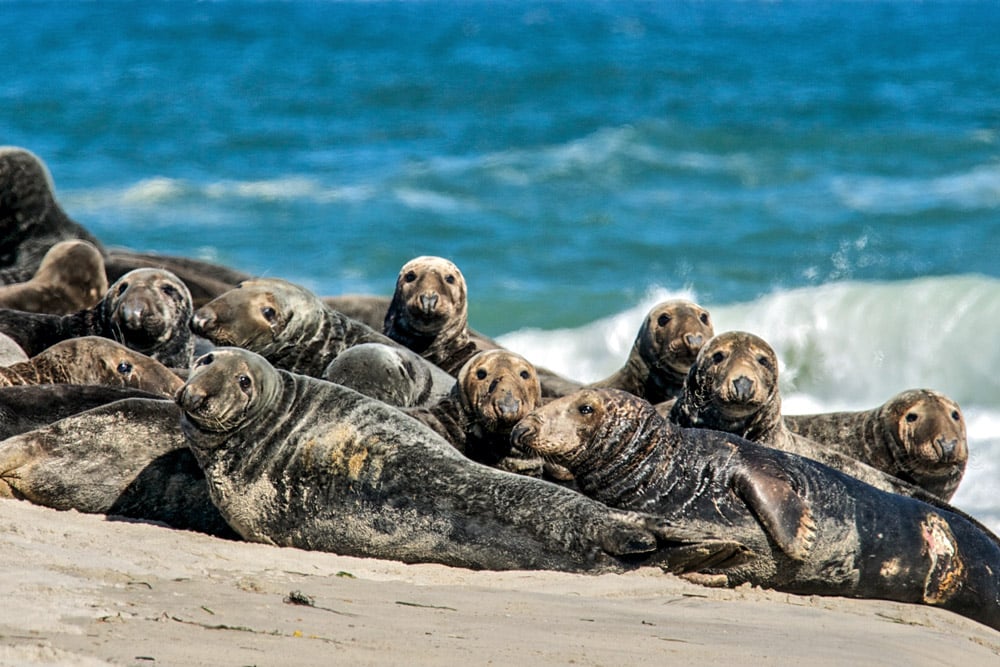
Grey seals on Monomoy National Wildlife Refuge, Cape Cod USA. © John J King
Fortunately, public opinion about the great whites’ ‘homecoming’ is, on the whole, accepting, with careful and considered awareness campaigns having taken priority from the beginning, headed by groups such as the Atlantic White Shark Conservancy. ‘Most people are reasonable and understand that the presence of white sharks off Cape Cod represents the restoration of a natural ecosystem,’ commented Skomal.
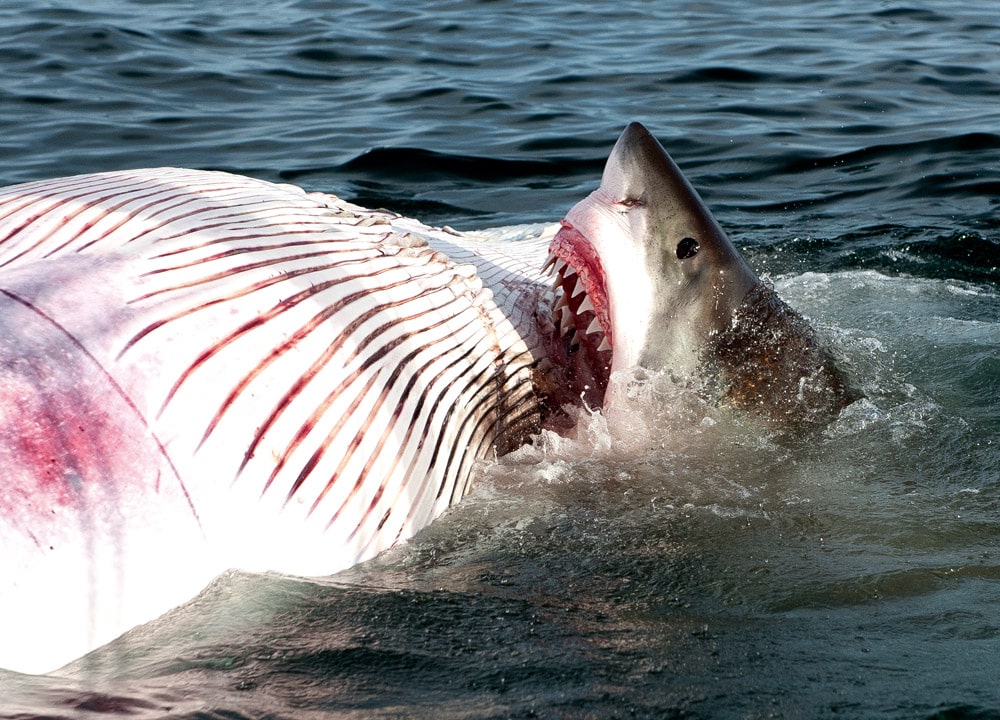
White shark feeds on whale carcass Cape Cod USA © Pam King
And climate change?
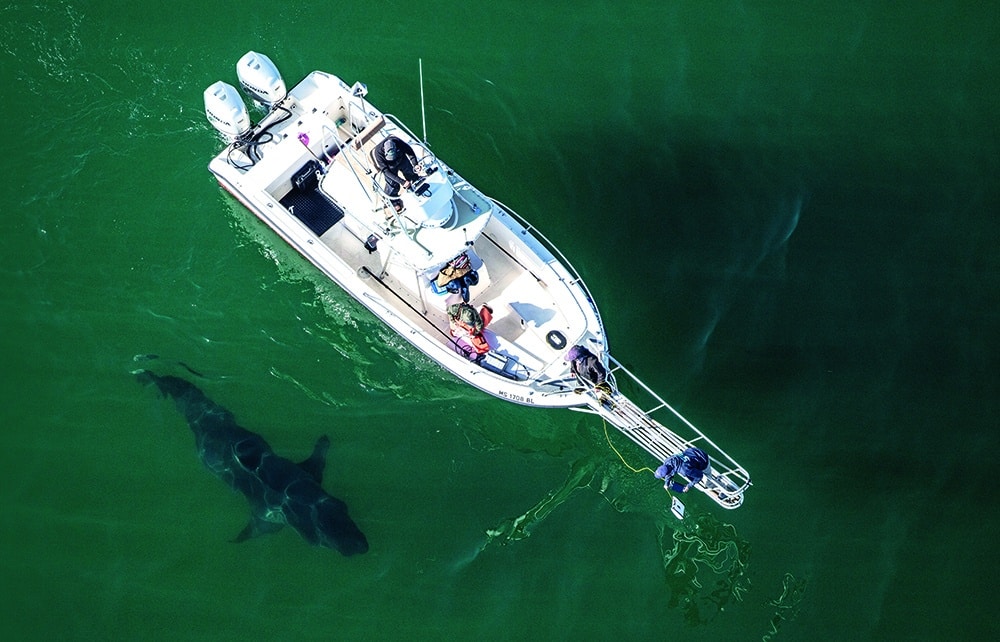
Tagged shark South Australia © Andrew Fox
With all these dramatic changes to the South African and North-West Atlantic white shark populations already afoot, what else can we expect of these enigmatic beasts as climate change effects are felt around the oceans? Warmer waters are undoubtedly going to create significant shifts in most marine food webs as temperature plays such an important role in their mechanics and in the physiology of most marine animals. Already notable is the burgeoning population of juvenile white sharks preferring the waters of Monterey Bay, California. ‘We started seeing the heatwave after 2014, and that warmer water temperature along the coast opened up a swim corridor over 400 miles from Santa Barbara all the way up to Monterey Bay,’ said Monterey Bay Aquarium Director, John O’Sullivan. ‘It was one of the aquarium’s first examples of how climate change affected the marine animal.’
Water temperatures and the abundance of seals off UK coastlines seem to be in alignment with conditions that white sharks enjoy in other parts of their global range. So why, then, do we not see a thriving community of these predators here? First of all, from where would these sharks be swimming? It is possible, but very unlikely, that they would be coming all the way from their North-West Atlantic range: according to tagging studies done by scientific organisations such as OCEARCH, white sharks tend to stay their respective sides of the Mid-Atlantic ridge, with only two famous tagged females, Lydia and Nukumi, having crossed the divide from west to east. This means that the most likely sharks to swim north will do so from the Mediterranean.

Dr Greg Skomal tagging WS Cape Cod USA © Pam King
There is little doubt that this near-landlocked sea once supported a glut of large ocean predators that thrived on the bounty of tuna and other game fishes. Indeed, a white shark population of unknown size (but worryingly low genetic viability) is understood to be clinging to existence, bearing offspring in what’s left of the rich tuna fishing grounds of the Strait of Sicily. But with a 2018 State of World Fisheries and Aquaculture (SOFIA) report commissioned by the United Nations identifying the Mediterranean as the world’s most human-depleted sea (62% of fish stocks are categorised as overfished), it begs the question as to how such large predators are managing to ‘earn a living’ with what prey is left, while themselves avoiding injury and death by capture. Ironically, this bodes well for worried water users who may be wondering if warming waters will see great whites frequenting the UK. Some marine scientists maintain that the numbers of Mediterranean white sharks are so limited that the chances of encountering them in UK waters are pretty low, but anecdotal reports that contest this continue to grow. Richard Peirce, former chairman of the UK’s Shark Trust, has investigated nearly 100 claimed sightings of great white sharks around the British Isles and found that this number can be whittled down to just seven possible sightings. Peirce remains convinced that the odd vagrant is possible, but without a single confirmed sighting, swimmers should keep their bathers on and unknotted! As the food supply in the Mediterranean dwindles, and as waters begin to heat up around the UK, this would appear to appeal to the white’s preference for temperatures between 12°C and 24°C, but with seemingly very low numbers of these animals within swimmable distance, it is unlikely that there will be an invasion! Bear in mind that even in regions where these predators are thriving, one is twice as likely to die in a vending machine accident, or to be bitten by another human being, as to be attacked by a white shark. Statistics matter!
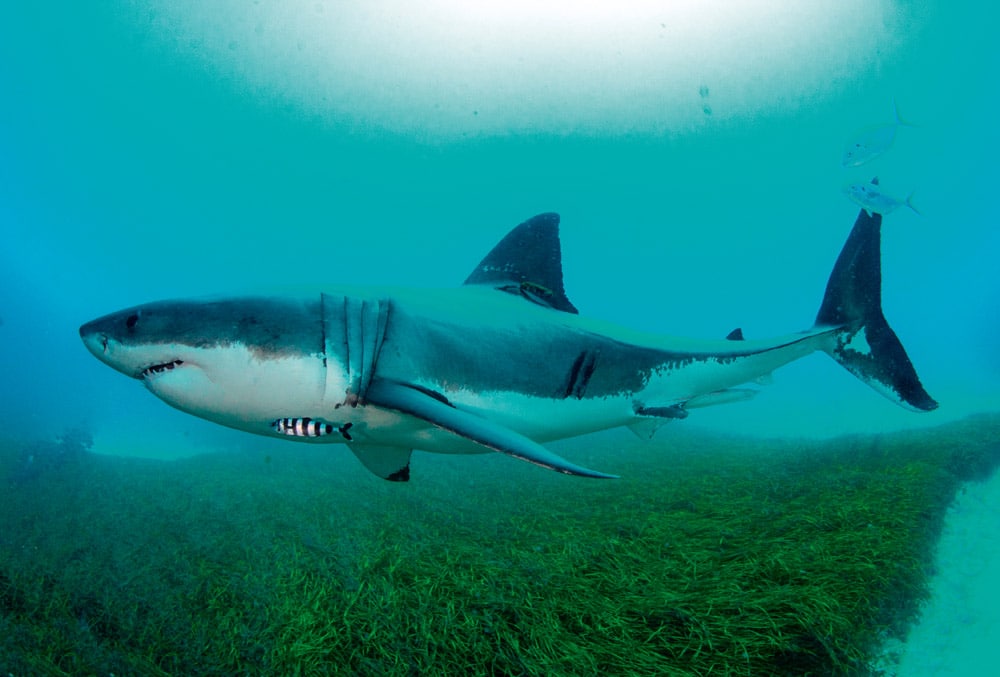
Tagged shark South Australia © Andrew Fox
Final thoughts
The hope of the great white’s story persisting through human dominion hangs on tenterhooks, along with that of a further one-third of its shark and ray relatives. While some populations of these apex predators appear to be on the rise, some are in disturbing decline, and there are some about which we know next to nothing, let alone how climate change will affect them. Tallying the numbers is futile. My personal hope for this species? While we get better at enforcing the protection laws for both them and their prey, collaborating across the species’ full global range, improving our data collection methods and reducing sharks’ accidental capture, these great hunters will learn ways to survive our ruthless reign. Sharks have overcome five mass extinction events during their estimated 420 million-year tenure, but none as daunting as their current challenge: surviving the age of man …
Cages and sharks
A convenient way for shark scientists to gain access to shark data is to team up with tourism operators that are with the predators on a routine basis at the best-known aggregation sites: the USA’s Farallon Islands, Mexico’s Guadalupe Island, Australia’s Neptune Islands, New Zealand’s Foveaux Strait and the southern tip of South Africa where boats operate into either False Bay, Gansbaai or Mossel Bay. Responsible cage diving is a non-consumptive utilisation of white sharks bringing incredible economic and scientific gains, as well as keeping poachers and illegal fishing vessels away from protected areas where sharks are vulnerable. Concerns that cage diving with white sharks conditions the animals to humans and boats, thereby increasing the risks to nearby swimming communities, have been addressed in several studies, with no links yet validated. Studies conducted in Australia’s Neptune Islands have, however, found some impacts on the sharks in terms of their energy budget (they used more energy when around cage diving operations), and some changes in swimming behaviours were observed. But if we were to ask the sharks whether they would prefer to live with cages or hooks, it’s certain that they would forgo being part of a global shark fishery for which the total annual landed revenue stands at US$630 million, and declining, due to overfishing. Incidentally, the global shark diving tourism industry has recently been valued at US$314 million, and is likely to double within 15 years. Shark tourism, when done correctly, appears to help much more than harm.
Slow Breeders
- Great whites are slow breeders producing on average between two and 12 (and up to 17) pups per litter after a gestation period of approximately 18 months.
- Females only begin breeding around 15 years (4.5–5 metres) and males around 10 years (3.5–4 metres).
- They give birth to live young that are left to fend for themselves.
Further information
- Excellent write-up about the validity of white shark sightings in UK waters
- Richard Peirce on great white sightings in UK waters
- Follow OSEARCH’s shark tracks
- Infographic on shark tourism value
- Interested in meeting a great white in the flesh?

